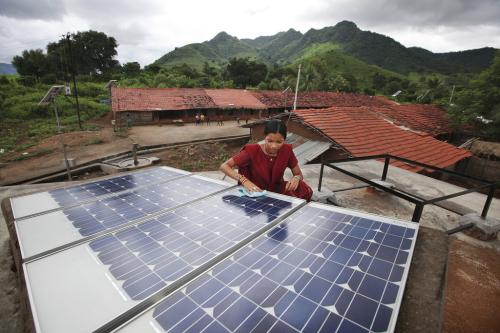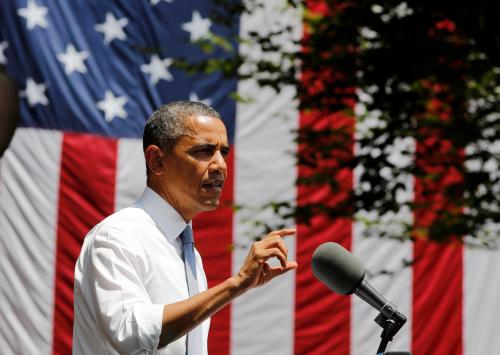Content from the Brookings Institution India Center is now archived. After seven years of an impactful partnership, as of September 11, 2020, Brookings India is now the Centre for Social and Economic Progress, an independent public policy institution based in India.
This article is a part of India 2024: Policy Priorities for the New Government, a compendium of policy briefs from scholars at Brookings India, edited by Dhruva Jaishankar and Zehra Kazmi, which identifies & addresses some of the most pressing challenges that India is likely to face in the next five years.
Providing affordable and accessible energy to every citizen while ensuring energy security has been the cornerstone of India’s energy policy. Over the years, this policy has been shaped by numerous socio-economic and political factors including the dichotomy between a nationalised Indian energy sector (upstream and downstream) and a more ‘liberated’ economy; centre-state relations; a rising middle class and ending energy and economic poverty. In recent years, technological changes and global developments on climate change have also played a role. Compared to India, most large nations faced the pressure of climate mitigation very late in their development path, meaning there is no proven pathway for development in climate change and sustainability that India can follow. How then can India direct its energy sector towards a low-carbon economy?
Make Clear Plans While Deregulating
Since India junked the central planning model, the ministries dealing with energy have put out several contradictory or competing targets and policies. These include the scaling up of electric vehicles to 100% of new stock by 2030; expanding refinery capacity to 400 million tonnes by 2030; increasing coal production to one billion tonnes by 2020; and changing the Renewable Energy (RE) targets almost every year. The lack of clarity on decision making and coordination often led to backtracking of policies (like in the case of electric vehicles) or changing goal posts (like the case of rooftop solar installation). The central government needs to provide cues to the market in the form of constant, clear and concise policies and legislation within a multiple objectives framework. This will necessitate planning, preferably by one body that takes into account an energy-economy approach. Furthermore, environmental regulations need to be strengthened. At present levels of consumption and groundwater depletion, India is expected to become a water scarce country by 2030. Similarly, seven of the most polluted cities in the world are in India. India needs Right to Clean Air and Right to Clean Water Acts or a new policy on environmental issues that highlights their critical nature and treats them as national emergencies.
At the same time, the central government has to play the role of a decision maker – making policy, framing legislation and arbitrating – but step away from energy production and distribution activities. Currently, the central government ministries are involved in framing policies, administering them, adjudicating disputes, and implementing policies either directly or indirectly, using public sector units as a proxy in the coal, oil and gas and power sectors. However, continued government intervention despite the evolution of the energy sector and the economy has led to market distortions, promoted rent-seeking, and encouraged biases and inefficiency.
Strengthen Independent Regulators
Because a single institution makes laws, administers them, and also adjudicates disputes, certain sectors lack regulators (coal, railways, and the environment) while other areas are not empowered sufficiently (oil and gas). Even in cases like the power sector, where the regulatory commissions have extensive powers at the state and national level, their efficiency and track record are not very strong. On coal, the environment, or the railways, the process is controlled by the relevant ministries or nationalised corporations and there is no forum for quasi-judicial recourse. In the oil and gas sector, the Directorate of Hydrocarbons (DGH) that oversees upstream activities does not have financial independence, falls under the Ministry of Petroleum and Natural Gas, and is staffed by members who are on deputation from National Oil Companies (NOCs). In 2011, the Supreme Court of India noted that regulatory jobs are reserved for career bureaucrats. These factors impact governance of the sector as a whole and act as deterrent for competition. There is a need for an independent energy sector regulator in India, either for the entire sector or several regulators for issues like coal and the environment. Moreover, to ensure independence of these regulators (and empower existing ones), it is necessary that they retain control over their finances, organisation, and hiring process with minimal interference from ministries and the bureaucracy.
Empower State Governments
In the energy sector, India has been moving away from the cooperative federalism model and has vested more powers in the central government. This move has resulted in policies that embody the principle of one-size-fits-all or a top-down method of policymaking. This approach has been detrimental since getting land, water, and environmental approvals require the buy-in of state governments. Further, this has also impacted the capacity and talent in state government bodies (ministries and independent bodies) to efficiently execute a plan of action. Given income and socio-economic disparity between states in the country, it becomes necessary to empower states beyond financial outlays. For example, in the natural gas sector, state governments are not interested parties in the infrastructure planning process and have different priorities. This makes acquiring land for laying pipelines or building CNG stations more difficult. Similarly, air pollution needs to be tackled by state governments with the Ministry of Environment, Forest and Climate Change (MoEFCC) only providing the adequate framework, incentives, and direction. The framework for the UDAY scheme becomes a viable case study where state governments were asked to act with appropriate directions and incentives from the central government, despite the legislative framework being drafted at the Ministry of Power.
The Brookings Institution is committed to quality, independence, and impact.
We are supported by a diverse array of funders. In line with our values and policies, each Brookings publication represents the sole views of its author(s).



Commentary
India 2024: An energised India
May 17, 2019